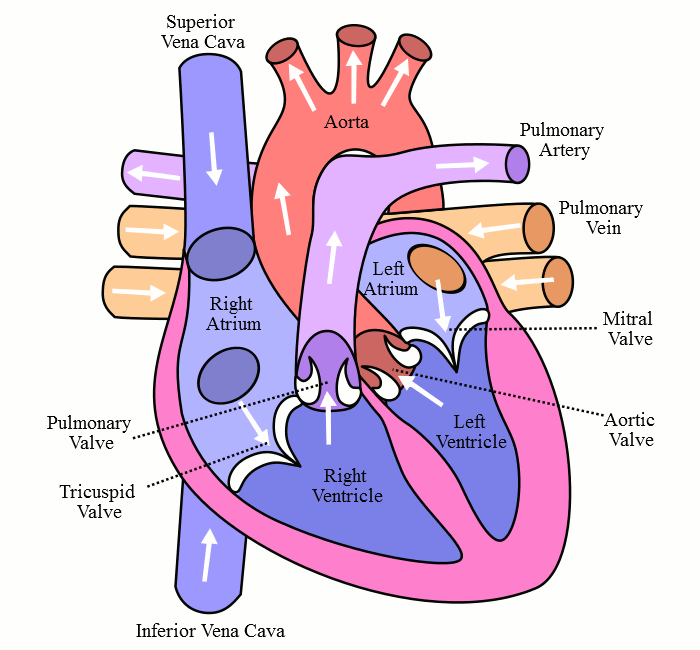
Explain blood circulation in Human Heart.
Answer
479.4k+ views
4 likes
Hint: The circulatory system is made up of arteries and veins which brings blood to the heart and supplies to other parts of the body. The heart is the main pumping organ which pumps deoxygenated blood to the lungs and oxygenated blood to all parts of the body.
Complete answer:
1.Heart is the main muscular organ which constantly supplies oxygenated blood to the brain and all parts of the body and also sends deoxygenated blood to lungs for oxygenation. The blood circulation in the heart is as follows-
2.The superior and inferior vena cava brings the deoxygenated blood from all the parts of the body to the right atrium.
3.The atrium contract and the blood flows from the atrium to the right ventricle through the tricuspid valve which regulates the flow of blood.
4.The ventricles contract and the blood through the pulmonic valve reach the pulmonary artery which carries blood to the lung for oxygenation.
5.Then the oxygen rich blood is brought back to heart by pulmonary vein to the left atrium.
6.The left atrium contracts and the blood from the atrium moves to the left ventricle through the mitral valve which prevents the backflow of the blood.
7.Further ventricles contract and the oxygenated blood is moved away from the heart through the aorta and arteries to all parts of the body. Aorta is guarded by an aortic valve.
The diagram below shows the blood flow through the heart.

Note: The wall of the heart is made up of cardiac muscles which facilitate the contraction of muscle and hereby facilitating the blood circulation. All the arteries in our body carry oxygenated blood except the pulmonary artery and all the veins carry deoxygenated blood except the pulmonary vein. The aorta is the largest artery in our body.
Complete answer:
1.Heart is the main muscular organ which constantly supplies oxygenated blood to the brain and all parts of the body and also sends deoxygenated blood to lungs for oxygenation. The blood circulation in the heart is as follows-
2.The superior and inferior vena cava brings the deoxygenated blood from all the parts of the body to the right atrium.
3.The atrium contract and the blood flows from the atrium to the right ventricle through the tricuspid valve which regulates the flow of blood.
4.The ventricles contract and the blood through the pulmonic valve reach the pulmonary artery which carries blood to the lung for oxygenation.
5.Then the oxygen rich blood is brought back to heart by pulmonary vein to the left atrium.
6.The left atrium contracts and the blood from the atrium moves to the left ventricle through the mitral valve which prevents the backflow of the blood.
7.Further ventricles contract and the oxygenated blood is moved away from the heart through the aorta and arteries to all parts of the body. Aorta is guarded by an aortic valve.
The diagram below shows the blood flow through the heart.

Note: The wall of the heart is made up of cardiac muscles which facilitate the contraction of muscle and hereby facilitating the blood circulation. All the arteries in our body carry oxygenated blood except the pulmonary artery and all the veins carry deoxygenated blood except the pulmonary vein. The aorta is the largest artery in our body.
Latest Vedantu courses for you
Grade 10 | MAHARASHTRABOARD | SCHOOL | English
Vedantu 10 Maharashtra Pro Lite (2025-26)
School Full course for MAHARASHTRABOARD students
₹33,300 per year
Recently Updated Pages
Master Class 11 English: Engaging Questions & Answers for Success

Master Class 11 Computer Science: Engaging Questions & Answers for Success

Master Class 11 Maths: Engaging Questions & Answers for Success

Master Class 11 Social Science: Engaging Questions & Answers for Success

Master Class 11 Physics: Engaging Questions & Answers for Success

Master Class 11 Chemistry: Engaging Questions & Answers for Success

Trending doubts
State and prove Bernoullis theorem class 11 physics CBSE

1 ton equals to A 100 kg B 1000 kg C 10 kg D 10000 class 11 physics CBSE

State the laws of reflection of light

One Metric ton is equal to kg A 10000 B 1000 C 100 class 11 physics CBSE

Difference Between Prokaryotic Cells and Eukaryotic Cells

1 Quintal is equal to a 110 kg b 10 kg c 100kg d 1000 class 11 physics CBSE




